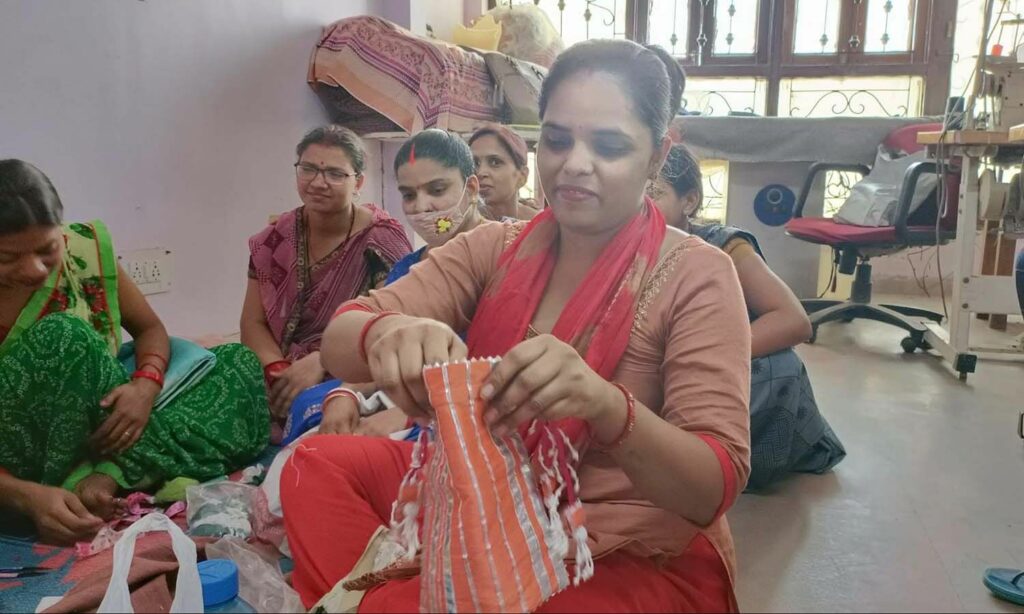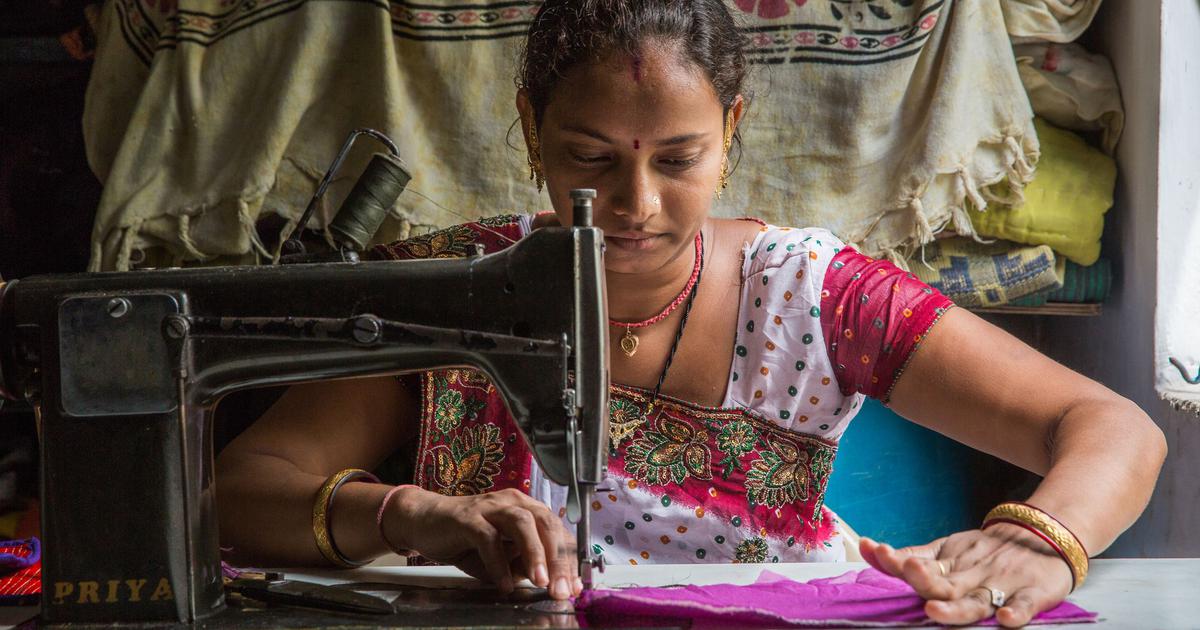Home-based workers remain invisible to the state’s policies, programmes and the public eye. They don’t feature anywhere in the popular understanding of Productive labour. Since most women home-based workers work out of their homes, their work, efforts and time spent are not noticed. Further, as the place of work itself is home, escaping from unpaid care work is inevitable.
Home-based workers remain invisible to the state’s policies, programmes and the public eye. They don’t feature anywhere in the popular understanding of Productive labour. Since most women home-based workers work out of their homes, their work and the efforts and time spent are not noticeable. Further, as the place of work itself is home, escaping from unpaid care work is inevitable.
Who are Female Home-Based Workers?
The Independent Group defines home-based workers as a) own-account workers and contributing family workers helping the own-account workers, involved in producing goods and services, in their homes, for the market and b) workers carrying out work in their homes for remuneration, resulting in a product or service as specified by the employer(s), irrespective of who provides the equipment, materials or other inputs used, and those contributing family workers helping such workers.
This leaves her working for 17-18 hours a day. During this, either she is doing the care work for her household or saving every bit of time to complete the paid work. She added, “If I don’t push myself in the night, I’m not going to complete my order. To get a substantial amount in hand, I have to complete more pieces of clothes. I can’t waste my time chit-chatting or in an afternoon nap.”
Home-based workers are engaged in labour-intensive manual economic activities and capital or information-intensive professional or clerical services. Home-based workers are near the bottom of India’s labour chain but is not a homogeneous group. Examples of such activities are stitching garments, preparation of shoe-uppers, making incense sticks, rolling of beedies, laundry services, assembling of electrical plugs or electronic components, professional and technical consultancy services, and data entry, processing and analysis services offered to individuals and businesses.
Although labour force participation rates for women are lower than for men in most countries, more women than men are home-based workers globally; women’s share is 57 per cent compared to 43 per cent for men. Social restrictions don’t prohibit women from working, but they prohibit them from working outside the home. The sexual division of labour leads to unrecognised and precarious ‘sexual division of space of work’.

Home-based work is mostly piece-per-rate work; hence every minute dedicated to working is essential to earn a substantial income. As per a statistical brief by WIEGO (Women in Informal Employment: Globalizing and Organizing, a global research – policy network focused on improving conditions for workers in the informal economy), in 2020, over half (53 percent) of women home-based workers worked as many as 36 hours per week in home-based work alone; over a quarter (29 percent) of women work 43 hours or more. The average workweek for women in home-based work is significantly lower than for men in urban and rural areas: an average of 38.5 hours for all women and 55.5 hours for all men.
Feminists have long challenged the public-private bifurcation of work, where waged labour in a defined workspace is accorded a higher value. Realising the importance of unwaged housework and care work of women, without which the productivity of waged labour would suffer, feminists have sought to redefine concepts such as ‘work’ and ‘labour’. Historically, workers try to maintain the 8x8x8 (work x leisure x rest-sleep) division of a day, whereas capitalists try to steal from workers’ leisure and resting time. For home-working women, there are no such divisions; at least, they are not obvious.
Most of the women in Sitara’s neighbourhood do similar work. They also mentioned how, initially, they would receive 8-9 rupees per piece for the same amount of work, has now reduced to 5-7 rupees. These rates of remuneration have pushed women further to work for extra hours.
Sitara’s Work Day
Sitara is a 32-year-old home-based worker from Ahmedabad. She stitches garments coming from a nearby Industry on a piece-per-rate basis. Sitara’s husband is a daily wage worker who earns an income of 5000-7000 monthly. Working as a home-based worker for Sitara is not just a pass-time but a powerful way to contribute to her household Income. She receives a payment of 5 to 7 rupees for each piece she completes. “I don’t have any stable income. Sometimes I earn more, sometimes less. It depends on the time I can take out from the housework.”

Sitara wakes at 6 AM and later sends her children and husband to work. She cleans the house, washes the dishes and cooks breakfast; later, when she gets time (mostly around 11 AM), she sits to work on her sewing machine. She purchased her machine six years back for 18,000 Rupees when she started the home-based work. Later, when her children are about to arrive from school(around 2:00 AM), she prepares lunch for the family.
After sending the children to tuition, she sits back on her sewing chair. This time she works till 6:00 PM and prepares the household’s food. Dinner is the only time she can be inside the bedroom and eat her food while watching TV. Later after her dinner, she comes to her veranda (where her machine is placed) and continues the work till 11 -12 PM. After, she lies down before starting the process again the next day at 6 AM.
Fulya Alikoc, in her article on home-based workers in Ghazi, applies Marx’s theory of ‘time wage’. She argues that the per piece rate payments and discontinued nature of the work make it difficult to establish how many hours are spent on necessary surplus and domestic labour, respectively.
Sitara structures her home-based work around the domestic care work she performs. How she starts a day varies per the everyday conditions of their children and husbands. This leaves her working for 17-18 hours a day. During this, either she is doing the care work for her household or saving every bit of time to complete the paid work. She added, “If I don’t push myself in the night, I’m not going to complete my order. To get a substantial amount in hand, I have to complete more pieces of clothes. I can’t waste my time chit-chatting or in an afternoon nap.”
As part of the urban working poor, home-based workers live in informal settlements, characterised by overcrowding and poor infrastructure. Acquiring basic amenities such as fetching water for the family could be an added burden on the women.
Most of the women in Sitara’s neighbourhood do similar work. They also mentioned how, initially, they would receive 8-9 rupees per piece for the same amount of work, which has now been reduced to 5-7 rupees. These rates of remuneration have pushed women further to work extra hours. The concept of time poverty fits well over here. As Jayati Ghosh, a professor of economics at the University of Massachusetts Amherst, states, “At its most banal level, it is the shortage of time available to devote to purely personal requirements, including leisure and relational activities.“
The burden of Time Poverty
The time poverty and work burden of women home-based workers is pushing them into longer work cycles, leaving women lethargic and restless. Fulya Alikoc, in her article on home-based workers in Ghazi, applies Marx’s theory of ‘time wage’. She argues that the per piece rate payments and discontinued nature of the work make it difficult to establish how many hours are spent on necessary surplus and domestic labour, respectively.
Fulya quoted, “The concept of the gendered working-day for Home-based workers in which women’s wage-labour and domestic-maternal labour are inseparably intermingled with each other through the spatial and temporal unitary structure of commodity-production and social reproduction.” Home-based work to flourish needs more efficient trade unions. A fair per piece rate is calculated for home-based workers.
Fighting to be paid a minimum wage is often the only legal tool for many workers in the unorganised sector and an issue around which workers are organised. The unionisation of home-based workers is also necessary when women don’t identify as workers. Fair pay for the work can lead to less surplus labour time for women in producing paid goods. But eventually, it’s essential not to forget that the struggle of women home-based workers is against the capitalist system and patriarchy.
About the author(s)
Anuj is an urban practitioner and an independent writer. He's mostly interested in Feminist Urbanism and the intersection of various identities in the urban. He is a graduate of the Indian Institute for Human Settlements and has disciplinary training in Urban and Regional planning.




